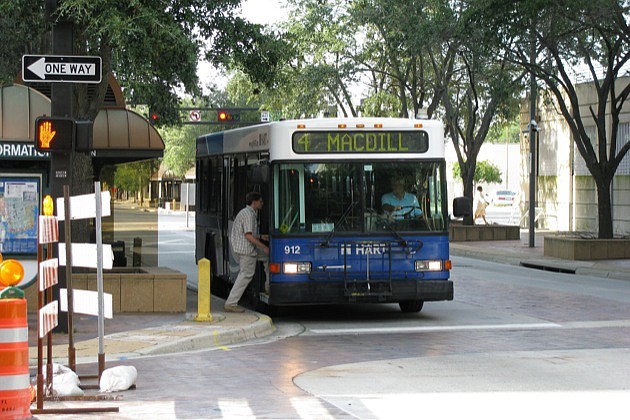There is not much positive spin the Tampa Bay Partnership is able to put on its latest Regional Economic Scorecard released Aug. 26.
The Bay area finished last among its six Southern peers, and the low ranking in transportation will be used in the campaign to fund light rail.
Partnership leaders say the scorecard study, conducted roughly twice each year, is intended as a meter measuring the Bay area against five other similar metros — Atlanta, Charlotte, Dallas, Jacksonville and Raleigh-Durham, N.C. — as well as a means of determining which categories need prioritizing in their three-year strategic plan, dubbed “A Model for Prosperity.” The area ranked third on the last scorecard released in January.
“There is a real tight margin between third and sixth,” says Mike Vail, president and COO of Tampa-based Sweetbay Supermarkets who leads the partnership's scorecard initiative. He says the Bay area needs to address creating higher-wage jobs to make a measurable and competitive difference in future scorecards.
Based on the latest scoring, the area needs to concentrate its efforts in all but one economic driver. Tampa Bay ranks third among its peers in education, in terms of its 78.5% high school graduation rate (Atlanta and Dallas are both above 80%) and trailing only Raleigh-Durham's Research Triangle in terms of workers with associate's and bachelor's degrees.
From there, the numbers aren't so good. Tampa Bay remained last in housing; fifth in employment/workforce, innovation and transportation; and fourth in income/productivity. Here's how each category breaks down:
• Employment and Workforce — While all six regions have experienced job losses over the past year, the Bay area had the worst unemployment rate at 13.1% and lost 54,000 jobs. Had Tampa Bay held on to just 1,500 of those jobs, we could have taken the fourth-place spot from Dallas, but at least the region's not as bad as Atlanta, which lost 84,000 jobs.
• Income and Productivity — Tampa Bay slipped into fourth from second in the last scorecard. While average wage growth tripled to 1.1% between last fall and this spring, the area's absolute average wage of $38,527 is last among the metros.
• Housing — The Bay area ranks sixth in rental affordability, a key factor in trying to attract young workers to the market. It costs 22.3% of the local median household income of $47,094 to be able to afford an apartment renting for $876 per month through the first half of this year. That same income covers just over one third of a median priced home.
• Innovation — Venture capital attracted per local worker improved slightly to $12, yet trails far behind $93 in Raleigh-Durham. The Bay area also generated 1.1 new patents issued for every 10,000 workers, but all other markets trailed the Triangle at 6.6.
• Transportation — The Bay area slipped into fifth place from third in the prior scorecard and was fourth in transportation investment per capita, at $253, but was first last time. Work commute times are comparable to other metros at around 25 minutes, but transit ridership as a percentage of total population was only 1.8%, compared with Charlotte at 3.8% and Atlanta at 7.1%.
The latest scorecard will undoubtedly come into play as campaigning gears up for Hillsborough County's proposed one-cent sales tax increase for transportation, up for vote in November. While much of that estimated $180 million annual revenue would be used to fund a new light-rail system in Tampa, other funds would go toward improving the county's current bus system and roads in suburban areas.
“Transportation is the number-one priority for this year,” says Stuart Rogel, president and CEO of the Tampa-based partnership. He points out that the issue isn't unique to Tampa among the partnership's eight member counties: Polk County, for example, is considering an additional half-cent tax to improve bus service, while Pinellas County is waiting to see how the Hillsborough referendum turns out to build its own rail connection in 2011 or 2012.
“That's what you have to do in this economy when you want to improve,” Rogel says about such community investments. “It boosts the economy, it creates growth and it prepares us for the next wave of development and growth.”
Gary Sasso, president and CEO of Tampa-based law firm Carlton Fields and the partnership's chairman, says the scorecard results will be used to show what action is needed to achieve measurable improvement and “move the needle” on all economic indicators to make Tampa Bay more competitive.
“This is relevant information for our discussions about regional priorities,” he says.
The Tampa Bay Partnership includes Hillsborough, Pinellas, Manatee, Sarasota, Pasco, Hernando and Polk counties, with Citrus County added earlier this year. The region encompasses 4.2 million residents, including 2 million workers.
The Regional Economic Scorecard has been conducted nine times since its introduction in January 2006. While the latest measure isn't the kind of news the partnership likes to tout about Tampa Bay, it is subject to change from one report to the next.
There are some indications things might be getting better already. Chris Steinocher, the partnership's COO and senior vice president of marketing and business development, points out that the region has received more site visits in the last 10 months than in the previous three years.






